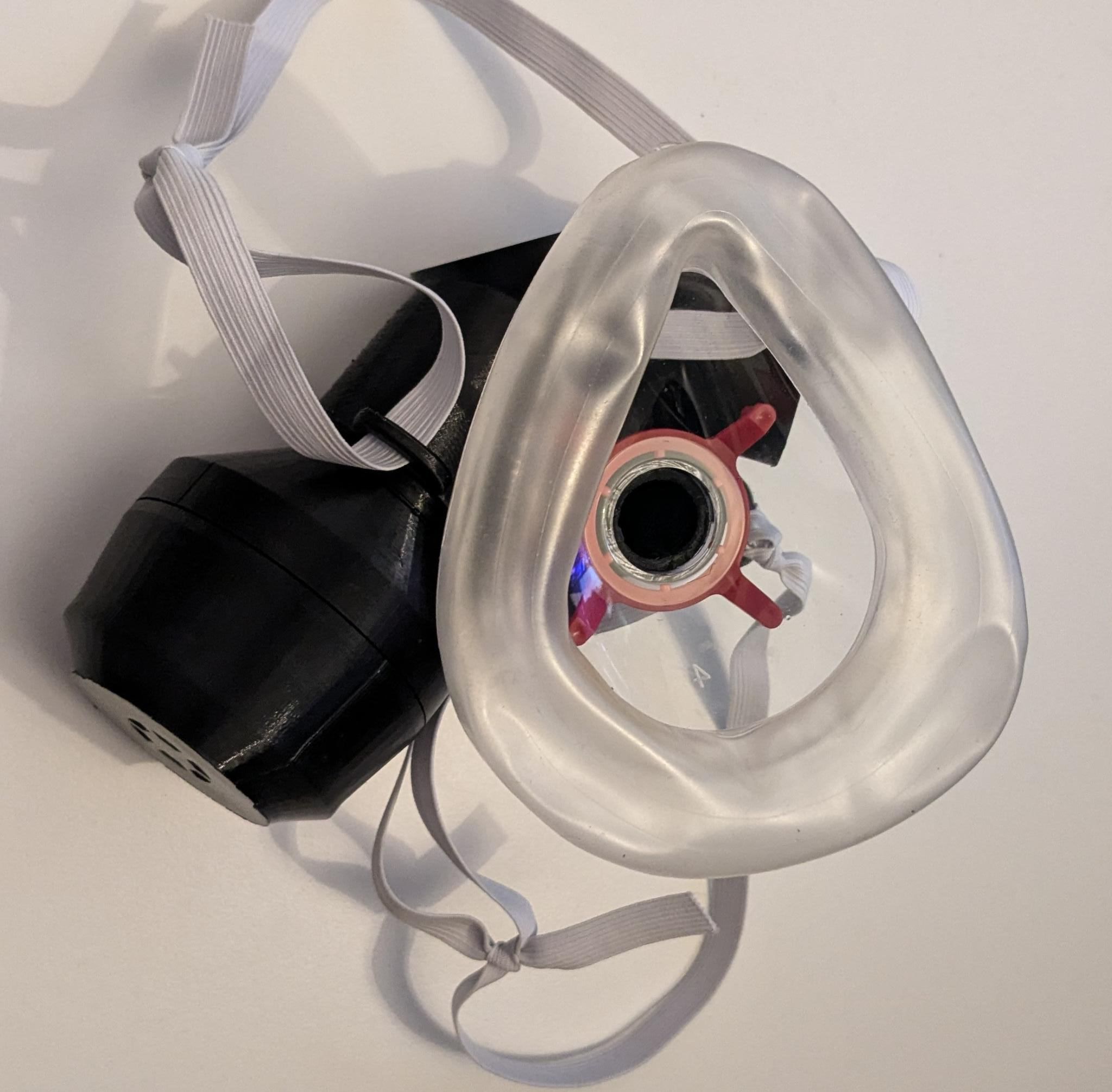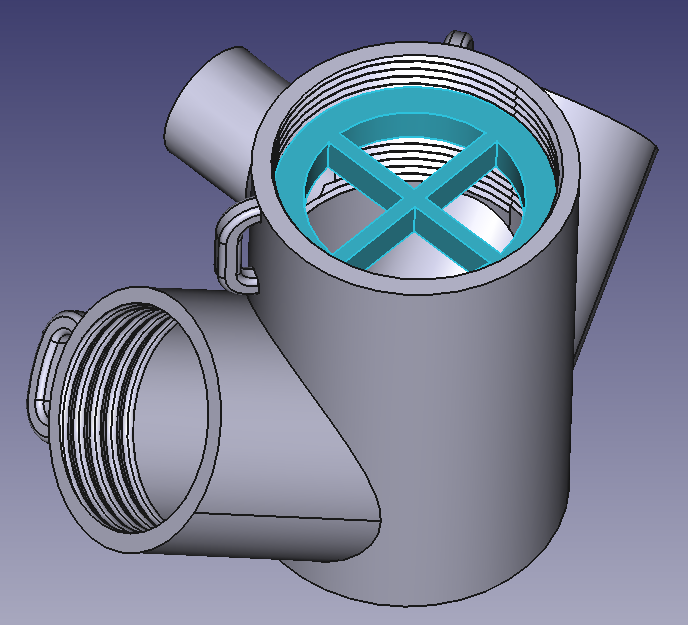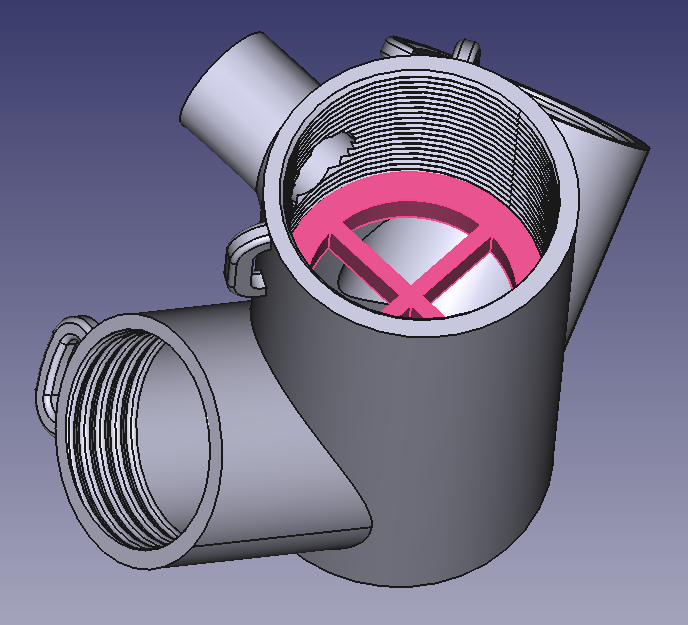20 KiB
3D Printed parametric gas-mask
Masque à gaz paramétrique imprimé en 3D (version francaise ici)



Here is the printable page for this model.
1 - General principle
There was many major version (8 in total) of this gas mask before arriving at a final design.
We will describe the general design principle of the latest version of the mask in this secion. The is also a similar section on the older version, that is more sucint as it is not the recommanded version at least not without you tweaking and understanding this version.
To know how to assemble/print this mask, see the section on mask assembly and printing, and if you want to change parameters check the section explaining parameters.
Maintenance
It is recommanded to apply grease (prefere food safe vaseline) arround thread, arround the insuflation mask connector and arround the perimeter of the one way valve to improve the seal.
If you are using a 3D printed (or DIY) filter (as described in the section bellow), change regularly the filter material - in general activated charcoal - and clean the enclosure if you don't change it.
In general do a fitment check before using the mask : put a piece of plastic (or your hand) at the entrance of the filter you are using, and breath in hard. You shouldn't fill air entering you lungs, and the mask should compress to you face under the suction force.
1.a - Interfacing with the face
The final design relies on an insuflation mask (with a standard 22m inner diameter connector) for good fittment to the face of the user. The advantage of this is that the fittment is good, there are mumtiple sizes to choose from, and insuflation mask are readly available (they are suppose to be single use only, and are used at every anesthesia, CPR and in many other cases) and cheap (there are some available for arround 2€ at medisafe.fr for example).
The downside of this method are that firstly these mask tend to deteriorate over time and with use as they are ment to be single use item, however they are obviously swapable so they can be switched when unsusable ; and secondly that the height of these mask and the length of the adapter puts the majority of the mask weight far from the face and thus a bit unconfortable, espacially under quick head movments.
For a mask that directly fit on the face, see the section on the older version.
1.b - Filter canister
This mask supports standard 40mm threaded canisters - sometimes also known as "nato threaded" canisters - which the standard dimensions are defined in sources/dimension/nato_thread_spec.png.
This mask can support two separate canisters, which can be advantageous if you need more filtration or less resistance to breathing, especially with smaller canisters. If you want to use a single canister, you can plug the other thread using a 40mm canister plug - one of which can be printed from the provided file (located at (distorsion/)3D-printed-parametric-40mm-gas-mask-canister/3Dfiles/nato_thread_plug.stl) in the submodule mentioned in the next paragraph.
We also provide a 3D printed canister following this standard and compatible with this mask and other standard gas mask in the distorsion/3D-printed-parametric-respiratory-one-way-valve repository, which is a submodule of this repository located at ./3D-printed-parametric-respiratory-one-way-valve. ⚠️ WARNING : Please don't use a 3D printed canister (or even our mask) in life threatening situations ! ⚠️ Or at least understand the inner working of gas mask and test your gas mask (especialy its fittment to your face) before using it.
There is also an older version of such a canister modeled within the file of the old gas mask version.
There also exist 3D printed adapter from this standard to other standard gas mask connector if you search on 3D printing site.
1.c - One way valve(s)
This maks uses a (one or two) 3D printed one-way valve : one for exhaling, and can also use one for inhaling. The design of the one way valve is presented in more detail in the distorsion/3D-printed-parametric-respiratory-one-way-valve repository, which is also a submodule of this repository present at ./sources/3D-printed-parametric-respiratory-one-way-valve.
The "ouput" one way valve (which is used for exhaling) is usefull to make breathing easier by not forcing you to exhale through the canister, while preventing air to come in without passing through the canister. A filter can be held in front of this valve to prevent particles from deposing at the exit of this valve, which could reduce its seal while inhaling. However, this valve is an output valve and will thus naturally push away suspended particles, and it is oriented down thus making gravity help in preveting particles from sticking to the valve. Thus to make the mask lighter it is not recommanded to use the longer version of the output valve that is made to hold a filter.
An "input" one way valve (used for inhaling) can be used to force air to not exit through the canister. This makes both exhaling and inhaling harder, and this thus not recomanded, at least without tweaking other parameters.
2 - Mask assembly and printing
2.a - Supplies : 3D Printing

Assembly of the mask is very simple, you wil first need to print :
- 1 main adapter from 3Dfiles/adapter_tube.stl
- supplies for the output one-way valve :
- 1 base for the one-way valve 3Dfiles/one_way_valve/owv_base_cap.stl
- either 1 membrane insert for the one-way valve 3Dfiles/one_way_valve/owv_membrane_insert.stl, or 1 separate membrane (printed out of TPU) 3Dfiles/one_way_valve/owv_separate_membrane.stl and 1 holder for the membrane 3Dfiles/one_way_valve/owv_separate_membrane_insert.stl
- Optionally : 1 cap to hold a filter at the exit of the one way valve 3Dfiles/one_way_valve/owv_base_cap.stl. ⚠️ Will require modifying the adapter tube file parameters ! ⚠️
- Optionally : supplies for an input-one way valve : ⚠️ Will require modifying the adapter tube file parameters ! ⚠️
- 1 base for the one-way valve 3Dfiles/one_way_valve/owv_base_cap.stl
- either 1 membrane insert for the one-way valve 3Dfiles/one_way_valve/owv_membrane_insert.stl, or 1 separate membrane (printed out of TPU) 3Dfiles/one_way_valve/owv_separate_membrane.stl and 1 holder for the membrane 3Dfiles/one_way_valve/owv_separate_membrane_insert.stl
Everything (except the separate membrane which is to be printed out of TPU, but can be replaced by a membrane insert) is very resilient to different print parameters and materials. We would suggest PETG, especially for the membrane insert which has to flex at each breath.
Print orientation are quite evident, altough we would suggest priting the adapter tube with the flat "top" surface on the bed, and using miniaml support to support the two threads ment to hold filters and to support the insuflation mask connector.
2.b - Supplies : Other supplies
You will also need extra supplies :
- 1 insuflation mask of the correct size
- ~1m/3ft of elastic to hold the mask to yor face
- either 2 compatible filter canister or 1 filter canister and 1 plug
2.c - Assembly : Insuflation mask and elastic straps
To assemble you can connect the insufltion mask to the adapter with the oppenig of the main tube of the adapter pointing toward the chin ; and tie two adjustable elastic loops (simply tie the elastic to one side, loop it through the other side and tie a knot onto itself so it can slide lengthening/shortening the elastic loop length) to the two pairs of tie-off points to hold the mask to your face.
2.d - Assembly : Output one-way valve

To assemble the output one-way valve you can first screw the base (3Dfiles/one_way_valve/owv_base_cap.stl) into the main tube of the adapter, with the smoother surface pointing down, until it is right under the tube that connect to the insuflation mask.

After greasing the surface you can screw the membrane insert (3Dfiles/one_way_valve/owv_membrane_insert.stl, or equivalently 3Dfiles/one_way_valve/owv_separate_membrane.stl and 3Dfiles/one_way_valve/owv_separate_membrane_insert.stl) until the membrane makes contact with the smooth surface of the base.

If you opted to use an output filter (⚠️ and have accordingly modified the parameters of the adapter tube, as shown in the above picture ⚠️), you can no put the filter aterial (coton, or some other minimaly ait-restricting material) at the output of the one-way valve, and thread a cap (3Dfiles/one_way_valve/owv_base_cap.stl) to hold it into place.
2.e - Assembly : Optional input one-way valve


Note that if you chose to use an input one-way valve (⚠️ and have accordingly modified the parameters of the adapter tube, as shown in the above picture ⚠️), you need to screw the same 3D-prints as for the output one-way valve before screwing the ones for the output one-way valve. The pieces for the input one-way valve would be screwed in the same order and orientation as for the output one-way valve, but would be screwed as far as possible into the adapter tube.
You can finally screw a canister or plug to each of the two thread, and you have an assembled mask !
3 - Explanation of parameters
If you want to changes the parameters of this design, you can edit the Freecad file 3Dfiles/gas_mask_v8.FCStd, which is fully parametric, with parameters present in the Spreadsheet.
Parameters are color coded, as is explained in the begining of the Spreadsheet.
If you want/need to change parameters, we would suggest you play with them and try to understand the impact of each parameters. We will only explain a small selection of important parameters that you are most likely to have to edit.
If you need to change multiple parametrs, you can right click on the name of the file in freecad "gas_mask_v8" then enable "skip recompute" so that you can change every parameters without recomputes, and the re-enable recomputes and right-click on the "adapter_tube" body and click "recompute".
3.a - Structural parameters
wall_thickness : [default=2.7mm] The wall thickness accross the print (except for the strap attachment point). Can be tweeked to make the print either stronger or weaker but lighter and faster to print.
snap_fit_clearance : [default=0.09mm] The clearance between two objects that would fit togeteher with difficulty. Also impact the clearance betwen threads.
3.b - Geometrical parameters
nt_horizontal_angle and nt_vertical_angle : [default=20° and 30°] The former is the horizontal angle away from the two arms of the adapter tube being perfectly parallel, havig such an angle is usefull to bring the center of mass clother to your face. The latter is similarly the vertical angle of the arms of the adapter tube, which is used to lower the center of mass so the adapter tube doesn't want to rotate around the connector of the insuflation mask under the weight of the filter canister.
3.c - Insuflation mask parameters
The mask diameter is standard to 22mm (set yt imc_max_outer_diameter).
imc_length : [default=20mm] Length of the connector of the insuflation mask. Can be adapted to your specific mask.
3.d - Strap holder parameters
sh_thickness : [default=4mm] Thickness of the strap holder. Can be adapted to your material and printing orientation so that you are confident that the strap holder won't break off when wearig the mask.
sh_bottom_angle and sh_top_angle: [default=60° and 25°] The former is the horizontal angle between the strap holders at the bottom of the adapter tube, and the latter is the angle of the top strap holders around the arm of the adatper tube.
sh_strap_width and sh_strap_hole_width: [default=15mm and 3mm] Width and passage width of the strap holder. Should be adatper to the elastic strap you are using.
3.e - One-way valve
Most of the parameters of the one-way valve are described in the readme of the associated repository : distorsion/3D-printed-parametric-respiratory-one-way-valve.
However we want to describe two parameters, as they are menionned here regarding the input one-way valve and the possibility of having a filter on the exit of the output one-way valve :
has_input_owv_1_yes_0_no : [default=0] If set to 1 rather than 0, will add the requiered length to screw an input one-way valve.
has_output_cover_owv_1_yes_0_no : [default=0] If set to 1 rather than 0, will add the requiered length to screw a cap to hold a filter at the exit of the output one-way valve.
4 - Older version




The older version of the mask - which was the 6th version (v6) - can be made either to work with standard 40mm cartrdige (as the newer version), or an integrated canister which makes it more confortable to use.
As this version is not the main supported version, we will not go into detail into explanation, and we will foccus on differences with the latest version.
We didn't put in the directory the .stl files for this version as it would have to be tweeked t be used anyway. You can edit the Freecad file located at 3Dfiles/older_version/gas_mask_v6.FCStd and export bodies to .stl to print them.
4.a - Older version : Interfacing with the face
This older version used a mold to mold a skirt that then creates a good seal with the face. For this skirt to be effective, the face measures have to be quite precise.
In the past we used silicone caulk for both this skirt and the one-way valve membrane. Although this is mechanically sound, this degases armfull checmical, and can thus not be worn safelly for at least wees or month if ever. We thus recommand either refining the modling technique to use pourable silicone, or making moldable silcone from pourable two-parts silicone and a filler material like corn starch. Do your own experiments !
4.b - Older version : Filter canister
The integrated filter canister is assembled and printed in the same way as the we provided in the repo and submodule distorsion/3D-printed-parametric-respiratory-one-way-valve.
The nato compatible canister simply consisted in an adapter that would provide a base to connect a 40mm gas mask to the same component as the integrated canister. There is also an adapter that connects to the gas mask like an integrated canster and converts it to a 40mm gas mask. This adapter is requiered as it also hold the one-way valve, which with an integrated canister is held in by the canister.
everything can be printed without support, except the canister cap which can be printed face down with support only the the central hole.
4.c - Older version : One way valve
Here the one way valve consist of an insert holding a silicone membrane, which can either be molded or cut off of a silicone sheet.
We chose to not use this design anymore as such a soft but small valve, while providing the same (or even a lower) cracking pressure as the larger stiffer membrane of the newer design, has the issue of letting air pass when there isn't a high enough negative pressure to close the membrane.
4.d - Older version : Short explanation of parameters
As with the latest version, parameters are color coded, as is explained in the begining of the Spreadsheet within the Freecad file 3Dfiles/older_version/gas_mask_v6.FCStd.
Structural parameters are largely the same between this version and the newest version.
Parameters that are presented in gray are target values that can be applied to other parameters (that share part of the name) to obtain a certain effect - mainly using the integrated canister or having the minimal size to use the nato-adapter with a 40mm canister -; which can also be done by seting to O istead of 1 the "direct mount (1) or nato thread mount (0)" field associated to the dm1_nt0_selector parameter.
You will also need to enter face measures, which are denoted by a pink color. You can check "mask_body -> face_interface -> Boolean -> mask_body_lip -> Pad011 -> Sketch020" to understand the exact meaning of each parameter, and thus how you should measure your own face.
License
"3D Printed parametric gas-mask" (c) by @distorsion
"3D Printed parametric gas-mask" is licensed under a
Creative Commons Attribution 4.0 International License.
You should have received a copy of the license along with this
work. If not, see <https://creativecommons.org/licenses/by/4.0/>.

